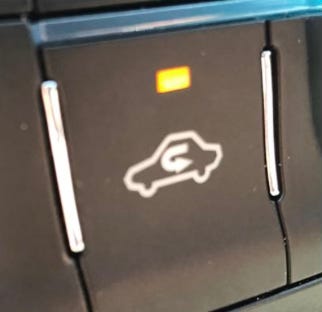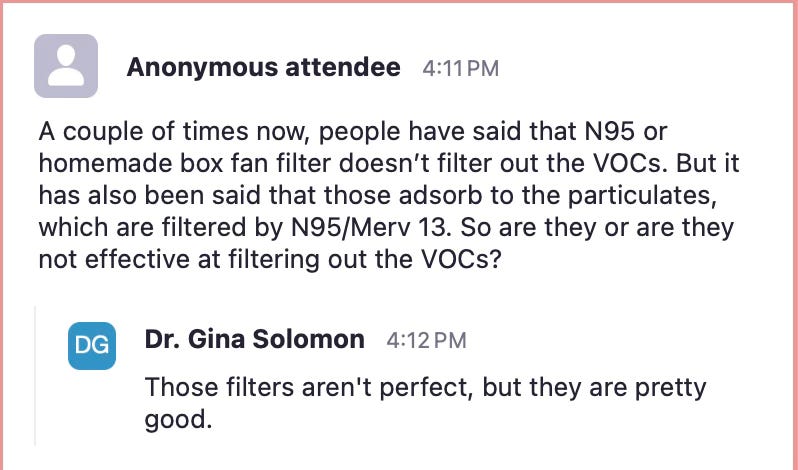I just watched a 2.5 hour webinar on air quality so you don't have to.
Though I do recommend it (unless this kind of thing makes you really anxious).
The webinar, organized by the Coalition for Clean Air, was titled “The Fires: Air Quality, Public Health, & What to Do Next.” It was recorded and will be posted to their site at some point in the near future (but is not yet at the time of this writing). It was supposed to be 1.5 hours and ran way over. Thousands of people stayed late.
Here are my top takeaways:
AQI
AQI measures two different sizes of particulates, 2.5 (smoke size) and 10 (dust size). It also measures ozone (which is more prevalent in the summer) and carbon monoxide, sulfur dioxide, and nitrogen dioxide. It does NOT measure asbestos, lead, VOCs, etc. HOWEVER, those tiny, nasty particles adsorb (stick to) the particulates that AQI does measure, so AQI is a decent proxy, according to the seven or so experts on this panel. They said that if AQI is in the green zone, it’s probably ok to go outside without a mask.
BUT!
They also said to use your common sense/sense organs. If it smells like smoke, wear a mask. If you see smoke, wear a mask. Additionally, the panelists also suggested a better AQI monitor than your Apple weather and suggested the South Coast AQMD app. I’ve played around with this a little and you can set alerts for air quality. You should be masking for an AQI worse than the green zone (forever, according to some panelists). Additionally, you should pay attention to which way the wind is blowing and whether or not you’re downwind from any of the fire zones. There is a place in the Watch Duty app where you can toggle on wind direction and also the Windy app.
Many people asked how far away from the fire is safe and/or how long after the fires is it safe and they just don’t have answers to those questions (though wind direction is important for the first part).
Filtration
N95s are good. They are better than KN95s (the straps should wrap around your head, not just your ears). The P100 mask is necessary if you’re going to a burn site (as is a bunch of protective clothing. Definitely don’t go to a burn site unless you have to). The online tutorials for making homemade air purifiers are good (make sure to use MERV 13 or higher and to not run these unattended because you might burn out the motor and start a fire). If you want to buy an air purifier, they suggested checking this site for quality purifiers. They also recommended switching your HVAC (if you can), so that it recirculates air instead of pulling it from outside. Ideally, your HVAC uses MERV 13 filters. However, you should definitely check what your unit can handle, because a MERV 13 filter may blow out your motor. You can also recirculate air in your car. This is the button you want to hit for that:
Your car also has a cabin air filter (usually accessed through the glove box) that you should probably replace. Look for a high quality, carbon activated aftermarket replacement.
A lot has just not been researched and there are no sure answers. Here’s a question I asked:
Drinking Water Contamination
Issued water warnings are primarily in the areas where the fires occurred. Typically, the contamination happens because smoke gets into the water system and adheres to the inside of the pipes. If this is the case, you should not drink or even shower in this water. For the Paradise fire, it took six months to remedy this and ensure that water was safe.
Cleaning Up
If you are not in a burn zone and there are ashes around your house, that means that the wind has blown in your direction. You should wear an N95 when cleaning ashes and should wet them down—no dry sweeping! Scoop them up and put them in a plastic trash bag and throw them in the trash (not the green bin). When you vacuum indoors, you want to use a HEPA filter vacuum, otherwise you are just kicking up dangerous dust particles.
The burn zones are very dangerous from a health perspective. People’s instinct is to return to their homes to salvage whatever they can, but please try to delay this as much as possible, if you can. If you need to go to your home, please wear the proper protective clothing, including, but not limited to a high quality respirator, possibly a Tyvek suit, sturdy boots, etc. Please look for more guidelines about visiting a burn site.
Pets
Use the same gauges you’re using for yourself for your pets. If it’s a mask day for you, make your dog walks shorter. Wipe pets’ feet off when they come inside (also you should not be wearing your outside shoes inside).
When Will This Get Better?
Larger particles have already settled, but overall it’s going to be a while. It will be very helpful if/when it rains. Higher humidity will also help a lot. Both of these things will ground particulate matter. Ash removal from burn sites will probably take a year or two, so those are areas to avoid, if possible, for a while.
Those are my takeaways. I wanted to get the AQI information out as fast as possible. Obviously, a lot more was said. Some of it was pretty hard to listen to, but also some of it was a relief. I encourage you to watch the webinar when it becomes available.






thank you for taking the time 💕